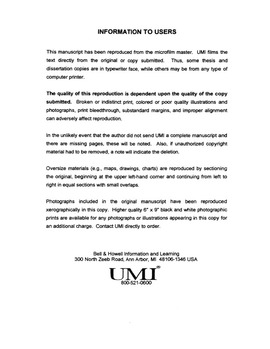| dc.contributor.advisor | Glatzhofer, Daniel T., | en_US |
| dc.contributor.author | Masterson, Douglas Scott. | en_US |
| dc.date.accessioned | 2013-08-16T12:30:44Z | |
| dc.date.available | 2013-08-16T12:30:44Z | |
| dc.date.issued | 1999 | en_US |
| dc.identifier.uri | https://hdl.handle.net/11244/5873 | |
| dc.description.abstract | The coordination of an iron cyclopentadienyl cation to the naphthalene moiety resulted in activation of the naphthalene ligand toward catalytic hydrogenation. Napthalene, and several dimethylnaphthalenes, when coordinated to the iron cyclopentadienyl cation, were readily reduced to their corresponding tetralin derivatives when subjected to mild catalytic hydrogenation conditions (1 atm. H2, MeOH, RT). The rate enhancement between complexed naphthalene and non-complexed naphthalene was ≫ 25X. Interestingly, the reduction proved selective with the methylnaphthalenes when the methyl groups were placed in the 1 or 4 position. When a mixture of 1,4-dimethylnaphthalene iron complexes (1:1.46, iron on unsubstituted:substituted ring) was subjected to catalytic hydrogenation conditions a 88% conversion to the corresponding tetralin products was observed with a selectivity of 1:26.20 (unsubstituted ring:substituted ring). Similar selectivities in the reduction products were observed for the following substrates: 1-methylnaphthalene (1:4.90), and 1,2-dimethylnaphthalene (1:13.90). A model which accounts for the observed selectivity of the iron moiety protecting the more substituted ring in the catalytic reduction of the dimethylnaphthalenes is presented. | en_US |
| dc.description.abstract | The synthesis, resolution, absolute configuration, and utilization in the copper catalyzed cyclopropanation reaction of several ligands based on the chiral monosubstituted [2.2]paracyclophane moiety are presented. Schiff-base ligands based on 4-amino[2.2]paracyclophane induced enantioselectivity in the copper catalyzed cyclopropanation of olefins with diazoesters. When N-salicylidene-4-amino[2.2]paracyclophane (5) was used as the asymmetric ligand in the cyclopropanation of styrene with tert-butyldiazoacetate (TBDA), a 96% conversion to product was observed and a 40% ee for the trans isomer was obtained. When the more bulky N-(2', 4'-di- tert-butyl)salicylidene-4-amino[2.2]paracyclophane (14) was used as the asymmetric ligand, an improved enantioselectivity of 67% was observed for the trans isomer in the cyclopropanation of styrene with ethyldiazoacetate (EDA). The best results were obtained using N-(4-paracyclophanyl)-2 '-hydroxyacetophenone imine (17) as the asymmetric ligand. When (R)-17 was used as the ligand a 76% ee was observed for the trans isomer in the cyclopropanation of styrene with EDA. All three ligands (5, 14, and 17 ) were capable of inducing significant enantioselectivity, for both the cis and trans isomers, with each of the following substrates: styrene, alpha-methylstyrene, 1,1-diphenylethylene. The copper catalyst derived from ligand 14 was unable to convert trans-stilbene and trans-4,4 '-dimethylstilbene to cyclopropane products. This is attributed to steric interference between the bulky ortho substituent in 14 and the approaching substrate. | en_US |
| dc.description.abstract | Mechanistic experiments were carried out which suggest that the cyclopropanation reaction using [2.2]paracyclophane based ligands proceeds by the same mechanism as other copper catalyzed cyclopropanation reactions of olefins with diazoesters. The active state of copper was found to be the +1 oxidation state and the reactive carbenoid species was found to have considerable electrophilic character. It was found that ligands 5 and 14 had similar abilities to control olefin approach to the active carbenoid site. This suggests that the enhanced enantioselectivity observed for ligand 14 relative to 5 is probably due to the electron donating ability of the added tert-butyl groups. | en_US |
| dc.description.abstract | Attempted hydrogenation of (eta6-naphthalene)chromium tricarbonyl complexes is presented. The attempted hydrogenation of chromium complexed naphthalenes failed to produce complexed tetralin products under catalytic hydrogenation conditions. The failure to undergo catalytic reduction is attributed to the chromium tricarbonyl moieties affinity for molecular hydrogen. | en_US |
| dc.format.extent | xviii, 165 leaves : | en_US |
| dc.subject | Hydrogenation. | en_US |
| dc.subject | Chemistry, Organic. | en_US |
| dc.subject | Alkenes. | en_US |
| dc.subject | Organometallic compounds. | en_US |
| dc.title | Copper catalyzed cyclopropanation using chiral [2.2]paracyclophane ligands and activation of naphthalenes toward catalytic hydrogenation by coordination of metal moieties. | en_US |
| dc.type | Thesis | en_US |
| dc.thesis.degree | Ph.D. | en_US |
| dc.thesis.degreeDiscipline | Department of Chemistry and Biochemistry | en_US |
| dc.note | Major Professor: Daniel T. Glatzhofer. | en_US |
| dc.note | Source: Dissertation Abstracts International, Volume: 60-11, Section: B, page: 5524. | en_US |
| ou.identifier | (UMI)AAI9949699 | en_US |
| ou.group | College of Arts and Sciences::Department of Chemistry and Biochemistry | |
